Forms of address in Pakistani english: A sociolinguistic analysis of variation, usage and pragmatic functions
DOI:
https://doi.org/10.71085/sss.04.03.362Keywords:
Pakistani English, Address terms, Corpus linguistics, World Englishes, PragmaticsAbstract
This study investigates patterns, frequency rates and pragmatic functions of address terms in the Pakistani English (PakE) i.e. a non-native variety of English. The research follows a corpus-based approach to investigate address terms used in formal and informal contexts and institutional settings through its own self-compiled PakE texts database. It applies AntConc software to reveal prevalent address terms before conducting a semantic analysis and comparing their utilization patterns against British and American English language patterns. Sociolinguistic interviews extend the research findings with cultural appropriateness analysis and pragmatic motivation data. The users of PakE incorporate address forms derived from both indigenous cultural traditions and colonial influences, thereby reflecting the multilingualism and hierarchical social structures characteristic of Pakistani society. This study develops World Englishes and pragmatics knowledge bases while generating practical learning benefits for Pakistani English language teaching practices.
Downloads
References
Ali, M. Z., Rauf, S., Javed, K., & Hussain, S. (2021). Improving hate speech detection of Urdu tweets using sentiment analysis. IEEE Access, 9, 84296-84305.
Anwar, B. (2012). A sociolinguistic study of Urdu-English code-switching in Pakistan (Doctoral dissertation, Bahauddin Zakariya University Multan).
Anwar, B., Iqbal, T., & Rasool, S. (2020a). Logical Connectors in Newspapers: A Comparative
Study of Pakistani and British Columns. Journal of Media Studies, 35(1).
Anwar, B., Ajmal, M., & Keezhatta, M. S. (2020b). Nativization of Grammatical Features in Pakistani English. Asian EFL Journal, 27(42), 92-106.
Anwar, B., Malik, N. A., & Shahbaz, M. (2020c). Innovative syntactic features of Pakistan
English newspapers. Kashmir Journal of Language Research (KJLR), 23(1).
Anwar, B., Butt, B., & Ali, G. (2020d). Adverb-adjective Collocations in Native and Non-native Journalistic Writing: A Comparative Study. Pakistan Journal of Languages and Translation Studies (1).
Arshad, N., Shahid, U., & Anwar, B. (2025). New Englishes and Local Context: Exploring Strategies of Pragmatic Nativization in Pakistani English. Journal of Arts and Linguistics Studies, 3(3), 3565-3580.
Ashraf, H., (2023). The ambivalent role of Urdu and English in multilingual Pakistan: a Bourdieusian study. Language policy, 22(1), pp.25-48.
Batool, K., Zhao, Z.Y., Atif, F. and Dilanchiev, A., (2022). Nexus between energy poverty and technological innovations: a pathway for addressing energy sustainability. Frontiers in Environmental Science, 10, p.888080.
Butt, B., & Anwar, B. (2019). NDTs in Non-native English: A Syntactic Analysis. Global Regional Review, 4(4), 299-309.
Fatima, M., Anwar, B., & Shahid, U. (2024). Placement of Adverbials in Pakistani English: A Pedagogical Perspective. Qlantic Journal of Social Sciences and Humanities, 5(4), 1-10.
Hafeez, A., Dangel, W.J., Ostroff, S.M., Kiani, A.G., Glenn, S.D., Abbas, J., Afzal, M.S., Afzal, S., Ahmad, S., Ahmed, A. and Ahmed, H., (2023). The state of health in Pakistan and its provinces and territories, 1990–2019: a systematic analysis for the Global Burden of Disease Study 2019. The Lancet Global Health, 11(2), pp. e229-e243.
Ino, L., Marhadi, A., Masri, F.A., Dinar, S.S., Halfian, W.O. and Gaho, R., (2023). “Good Morning, Fokoamau”: An Analysis of the Addressing Terms in Pancana Language. Theory and Practice in Language Studies, 13(10), pp.2544-2556.
Jabeen, S., (2023). Language planning and policy, and the medium of instruction in the multilingual Pakistan: a void to be filled. International Journal of Multilingualism, 20(2), pp.522-539.
Jamil, S., (2021). From digital divide to digital inclusion: Challenges for wide-ranging digitalization in Pakistan. Telecommunications Policy, 45(8), p.102206.
Kachru, B. B. (1985). Standards, codification and sociolinguistic realism: The English language in the outer circle. English in the world: Teaching and learning the language and literatures/Cambridge UP.
Kachru, B. B. (Ed.). (1992). The other tongue: English across cultures. University of Illinois press.
Kanwal, A., Riaz, R. and Shahid, M., (2023). Analyzing Address Forms in Pakistani Serial: A Gender Based Study. Hayatian Journal of Linguistics and Literature, 7(1), pp.21-42.
Malik, M.A., Mahroof, A. and Ashraf, M.A., (2021). Online university students’ perceptions on the awareness of, reasons for, and solutions to plagiarism in higher education: The development of the AS&P model to combat plagiarism. Applied Sciences, 11(24), p.12055.
Mushtaq, M., Saleem, T., Afzal, S. and Saleem, A., (2021). A corpus-based ideational meta-functional analysis of Pakistan Prime Minister Imran Khan’s speech at United Nations general assembly. Cogent Social Sciences, 7(1), p.1856999.
Muslimawati, N.S., (2022). Formal and informal language expressions used by English students of Indonesia in classroom presentation-interaction. Elsya: Journal of English Language Studies, 4(1), pp.12-23.
Nazeer, S. and Gil, Y., (2023). Embracing artificial intelligence challenges for public sector organizations in Pakistan. Journal of Contemporary Studies, 12(1), pp.35-52.
Phulpoto, S.A.J., Oad, L. and Imran, M., (2024). Enhancing Teacher Performance in E-Learning: Addressing Barriers and Promoting Sustainable Education in Public Universities of Pakistan. Pakistan Languages and Humanities Review, 8(1), pp.418-429.
Ramzan, M., Mushtaq, A. and Ashraf, Z., (2023). Evacuation of difficulties and challenges for academic writing in ESL learning. University of Chitral Journal of Linguistics and Literature, 7(I), pp.42-49.
Saleem, T., Anjum, U. and Tahir, S., (2021). The sociopragmatic and pragmalinguistic strategies in L2 pragmatic competence: A case of Pakistani ESL learners. Journal of Intercultural Communication Research, 50(2), pp.185-206.
Shahid, U., Anwar, B., & Amin, M. W. (2025). Cleft Constructions in British and Pakistani English Newspapers: A Comparative Analysis. Journal of Applied Linguistics and TESOL (JALT), 8(2), 2385-2395.
Soomro, M.A. and Larina, T., (2022). Categories of address forms in Pakistani English at a multilingual academic setting. Philological Sciences: Scientific Essays of Higher Education, pp.50-55.
Soomro, M.A. and Larina, T., (2023). Mister, bro, or ada? Styles of Addressing among Multilingual Pakistani Students. GEMA Online Journal of Language Studies, 23(2).
Soomro, M.A., (2023). The Use of Pakistani English Address Forms in an Academic Setting: University Teachers to Non-Teaching Staff. Филологические науки. Вопросы теории и практики, 16(2), pp.597-601.
Usman, M., Aziz, A. and Bashir, A., (2023). A Sociolinguistic Study of the Choice of Address Forms Used by Spouses in the Punjab, Pakistan. Journal of Arts and Linguistics Studies, 1(3), pp.565-586.
Wang, S., Ramdani, J.M., Sun, S., Bose, P. and Gao, X., (2024). Naming research participants in qualitative language learning research: Numbers, pseudonyms, or real names? Journal of language, identity & education, pp.1-14.
Downloads
Published
Data Availability Statement
The data that support the findings of this study are available from the corresponding author upon reasonable request.


































